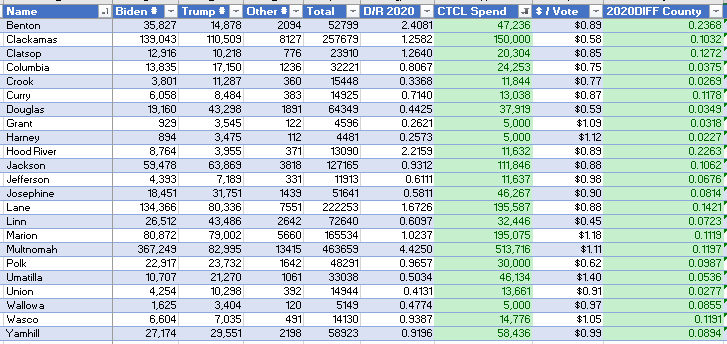Introduction
Question: Is CTCL misrepresenting the information on the IRS Form 990 stating that the PURPOSE of the grants were to help support the SAFE administration of public elections during the Covid-19 pandemic?
Answer: It appears so given the results of both aggregate, state and county by county analysis as we will see below. It appears this is a quantifiable democrat ballot harvesting operation.
Background
This is Part XXXI in The NGO Project series which examines the role NGOs had in determinative outcomes in the 2020 Presidential Election. In prior articles, I focused on the effect the Center for Technology and Civic Life (CTCL) had on AZ, CO, CT, GA, IA, IL, ME, ME, MI, MN, MT,NC, NH, NJ, NE, NM, NY, OH, PA, RI, TN, TX, UT, VT, VA, WA and WI.
This article will solely focus on CTCL in Oregon (OR).
Calculation Basis
The calculation basis was previously explained in detail here. In this article, I do make one adjustment and that is to calculate the 2020DIFF factor by weighted average rather than arithmetic average.
Analysis
23 of 36 OR counties (64%) received CTCL grants.
Total votes cast in CTCL counties were ~ 1,772,778 (75%) and NonCTCL counties was ~ 601,543 (25%). To state it a different way, on a per county basis, CTCL had the opportunity to influence 75% of OR voters.
The total amount of grants to OR was ~ $1,600,807 and the value of individual grants ranged from ~ $5,000 to $513,000.
This table includes the top 5 CTCL grants by county.
$1,166,224 of the grants (67%) were focused in the 5 counties above. 45% of that was in Multnomah County where Portland is located. The $/vote spent by CTCL in these five counties range from $0.58/vote to $1.11/vote (all parties). The vote totals in these 5 counties account for ~52% of the votes in OR.
To state that a different way, 67% of the grants were spent on 52% of the total votes cast in OR. Is that fair if this was all about a Plandemic?
The average 2016 D/R ratio for CTCL Counties was 0.952 (not weighted). The average 2016 D/R ratio for NonCTCL Counties was 0.609 (not weighted). This means that CTCL grants were provided to more D leaning counties. The top 5 counties in terms grants had a average 2016 D/R ratio of 2.368….big time D areas for sure. This is ~5x the NonCTCL county average in 2016. More bias in favor of D.
To continue on this track, if you look at all the counties in 2016 that had a D/R ratio of less than one (R leaning counties), there were 28 (78%) counties. In total, they received ~ $662,332 in grants in 2020. This is ~ 41% of the total 2020 CTCL grants in OR. These counties contributed ~809,000 votes (all parties) in 2016 which is the same 41% of the vote total.
The top R leaning counties in 2016 that received CTCL money in 2020…..
Do these facts alone confirm or disapprove my thesis that the grants were NOT used for public safety?
2020DIFF Calculated with Weighted Average
For this analysis, I used a slightly different way to calculate the 2020DIFF using a weighted average based on total votes in a county. This is what it looks like.
w = Total County Vote / Total State Vote
a = D/R2020 - D/R2016 (for CTCL Counties)
a' = a * w (per county)
2020DIFF = sum(a'1:a'n)
This method in theory permits a better correlation for D vote harvesting because it is weighted for counties with higher vote totals.
Now things get weird in OR…..just like WA by the way.
Before I even get into this, OR broke the model. Why?
All I can say is this.
Washington (WA) and Deschutes (DC) Counties look very very “fishy” to me. These are NonCTCL counties (didn’t get grants) that had a YUGE heavy tilt in the D direction. They LOOK like CTCL counties, but they are not. Check this out. 2020DIFF County factors of 0.2565 and 0.2770. I might put Lincoln in the mix as well.
Here are the numbers anyway to illustrate my point.
The 2020DIFF for CTCL counties is 0.110 and for NonCTCL counties it is 0.221. This means that the CTCL D vote harvesting factor in CTCL entities is 0.110-0.221 = -0.111 or ~ -11%.
So I have to conclude one of the following
CTCL grants actually increased R turnout as a ratio to D between 2016 and 2020
or
Non CTCL counties adjacent to CTCL counties benefited in some way due to the grants in CTCL counties.
You decide.
These are all of the CTCL counties. This is the first state I have looked at where not a single county trended more R as indicated by a -2020DIFF…..hard for me to believe that is organic human behavior.
Noteworthy R Stalwarts
There are none as stated above.
Conclusion
CTCL issued ~$1.6MM grants in OR. It was not possible to calculate a D vote harvesting factor for this state. Either CTCL grants turned out R voters OR the grant money provided to certain counties benefited nearby counties that did no receive grants.
You decide.
All Counties
References
CTCL IRS Form 990 (revised form from Jan 2022 used)
Telegram - https://t.me/electiondataanalyzer
Truth - @ElectionDataAnalyzer
The math here is simple, try this on your own. It is a model to look for trends, not an exact science.








is there any comparable study on the Rational for unclean voter rolls impact? Oregon has Multnomah and Lane Counties with known unclean voter rolls for over 4 years. If this question is inappropriate I apologize. In having skills, numbers are not one of the huge list.
"It appears this is a quantifiable democrat ballot harvesting operation."
Is this the right conclusion for the apparently unusual Oregon analysis outcome or an erroneous unedited carryover from the template?